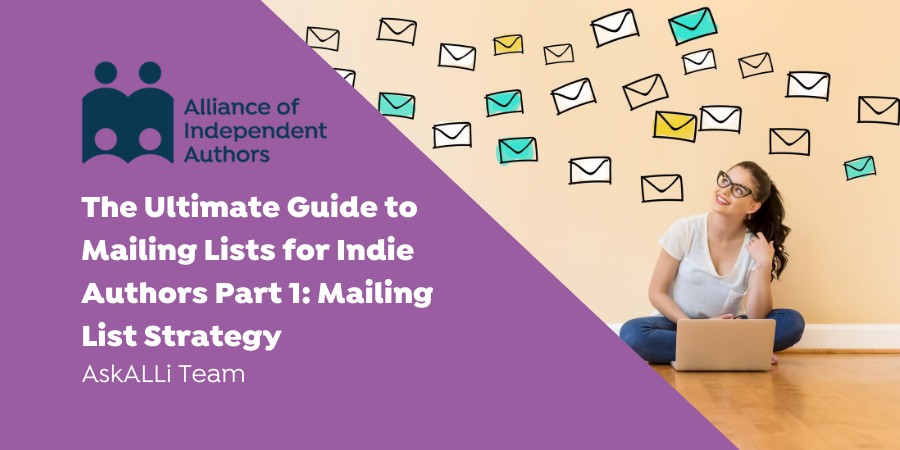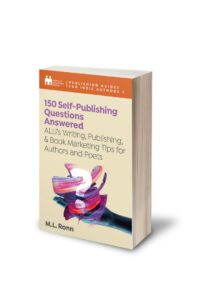In a three-part series starting today, the Alliance of Independent Authors #AskALLi team does a deep dive into email marketing for authors: how to set up your lists, how to grow them, manage them and use them to build and sustain great relationships with your readers. With deep thanks to all the ALLi members who took time to respond and special thanks to Heide Goody, Joseph Alexander, and Wendy H Jones for their contributions.
This is The ultimate guide to email marketing for indie authors Part 1. Setting up Your Reader Email List(s)
See The ultimate guide to email marketing for authors Part 2: Growing Your Reader Email List(s)
And The ultimate guide to email marketing for authors Part 3 : Maintaining your Reader Email List
Mailing Lists for Authors: Why Do You Need a Mailing List?
Let's begin with a quote from our latest guidebook, by ML Ronn in his 150 Self-Publishing Questions Answered: “Email isn’t dead. In fact, it’s the only way to get in touch with some people.
A mailing list allows you to email your biggest fans every time you have a new release. If you’re a newbie, you might not have very many people on your list at first, but as your journey progresses, your list can grow over time and can make you a lot of money.
Think about it like this: a reader finishes your book and LOVES it. Shouldn’t they have a way to find out when you have a new release? Exactly! Mailing lists are for the most devoted fans.
But I have my Facebook page for all that, we hear you say? No, no, no. Social media definitely has its uses but authors do best, over the long term, when we use social media to attract interest (see ACCESSS marketing below) but focus on getting those interested readers to sign up and subscribe to a mailing list that we own ourselves.
You can't depend on social media sites to always connect you with readers. What happens if Facebook, TikTok or Instagram goes bust or their popularity wanes? These sites come and go. (Do you recall Myspace? Exactly.) Your list is something you have control over, yourself.
And all the research shows that the closest connection we can have with the reader is by email. People flit and scroll through social posts but engage much more deeply with words and images that land in an inbox. Email is, says Written Word Media a company that has built a business on the tool, simply “the most effective marketing tool out there” for authors, allowing us to reach a wide group of readers in a meaningful way.
We recently did a post about authenticity for authors, in which we explored this concept of “know, like and trust” in marketing: The Ultimate Guide to Authenticity for Indie Authors. As explained in that post, in all industries people want to buy from those they know, like, and trust. Carefully crafted emails are a great way for your readers to come to know, like, and trust you. Once that happens, you don't have to persuade them to buy. They'll be hounding you about when your next book is out, and can they review it, and asking whether there any other way they can get more of what you do.
For all these reasons, email marketing is the core communication recommended in ALLi's ACCESS marketing, a marketing method which we'll be explaining in more detail in an upcoming post. For now, a summary will explain the use of email in turning casual social media browsers into engaged fans and superfans.
Use the ACCESS model to Create an Email Marketing List
ACCESS marketing is a sequence of progressive actions that takes your readers from discovering you or your writing to engaging with you and subscribing to your email list. From there, you continue to satisfy their need for entertainment, knowledge or inspiration, even more.
As the word implies, what you're after is access. Access to your reader's email inbox. And you're willing to do the work–craft work and emotional labor–that will gain that precious access and keep it.
Here's how:
ACCESS marketing encourages us to be creators, not hustlers, in our social and email marketing activities. ACCESSS stands for:
- attract
- captivate
- connect
- engage
- subscribe
- satisfy
Selling books to this group then becomes easy, and there’s nothing salesy about it. It’s just a matter of sending an email or other message to readers who already know, like and trust you and your work.
The author is not pushing their work on readers, the readers are asking “when is the next book out?”
• Attract – offer social media or other posts that your ideal reader can easily find or trip across online and freely consume. Your attractor content must be carefully crafted to hook the right readers (pay attention to images as well as words) and have real value.
As not everybody is to take their connection with these posts any further, it's usually a good idea if you can use these posts to get you more words for your work-in-progress–maybe building out characters or plots (fiction), exploring concepts or ideas (nonfiction), putting out stanzas or illustrations (poetry books)–or otherwise build something that has value for your author business. If you do choose to do this, remember that your social media offerings are a separate format for your words, and you'll need to block out time to properly craft them—and what ends up in the book will need editing to fit.
At this stage of the ACCESSS process, you're looking for quality “likes” and “follows” from the right people i.e. the right readers for your books. Don't pursue likes or follows for their own sake–it's not about how many followers you have but how much they like what you're putting out. Quality, not quantity. You're aiming to delight them so much that they move from this social media channel into one of your own, owned email funnels. (See below)
• Captivate – keep those who have followed or liked your offerings interested and continually attract newcomers by regularly posting captivating content. Discipline yourself to only post content that your readers will love and that keep your attractor channels clean and clear. If you write different kinds of books, genres or niches, you'll need separate attractor offerings, channels and funnels for each (see Orna Ross case study in Part 3 for more on this) but set up one channel fully first. Far too many authors have a presence on two, three or even more social media channels, none of which are actually working for them. A reader should be able to tell by the most cursory look at your attractor channel (social media account, ads) what your books are about.
• Connect – Have an easily accessible mail address where a reader or follower can connect with you. Regularly invite email contact. When somebody does contact you, make sure you respond in a voice appropriate to the content you've been publishing for those readers and in a way that satisfies their needs. When you've solved their problem, entertained, informed or inspired them, as appropriate, ask their permission to add them to your email list, explaining the benefits of subscribing.
• Engage – Make your channel meaningful by starting and nurturing conversations. Ask questions. Invite input into characters, plot turns (fiction), ideas and quandaries (nonfiction) word choices and formats (poetry). Share your love of books and reading, as well as writing, particularly your love of your subject matter, genre, niche. Bring them into the coolest aspects of being a writer (spare them your headaches, challenges and down days, unless you can make this amusing or otherwise entertaining).
• Subscribe – Invite your followers to subscribe by offering them what is often called a “lead magnet” or “reader magnet”. In business terms, it's also described as a “gift for prospects”. Again, it can be in text, audio or video format but as you're a writer who wants to sell more books, the ideal format is probably a free book. And again, it must have real value, be carefully crafted to align with your attractor content, and further hook the right readers.
As well as offering it on social, it can also be given out at the end of talks or events, and you might even want to carry a physical copy around with you to hand to strangers who ask what you do.
Whatever you offer must develop on what they've already received from you and align closely with the books and products you're going to want them to buy.
• Satisfy – Make your emails delightful and email regularly, on the promised schedule. The emails should perfectly match the social media communications or ads that originally attracted and engaged them and we must also write in a way that replicates and reinforces the writing style and creative intentions of our books.
See “Topics” below if you need ideas.
We write good emails when we think of them as forming part of our body of work. They shouldn’t just replicate what you’re putting out publicly on social media. They should make your readers feel valued, like they have access to something special.
The other part of delivery satisfaction is keeping your promises. Value your subscribers and your access to their inbox. If you want readers to open your emails then your emails must delight and excite. Remember the dictum of the great Maya Angelou, as true to email as to any other aspect of life: “People will forget what you said, people will forget what you did, but people will never forget how you made them feel.”
Once these ACCESS marketing steps are completed, selling to this group becomes easy. You're not pushing their work on readers, the readers are asking “when is the next book out?”
When the time comes, it is just a matter of sending an email or other message about the book and where to purchase. Readers already know, like and trust you and your work. They review positively and spread the word because you've done the work–craft work and emotional labor–that gains precious reader access and loyalty–and continues to nurture it.
With this positive relationship in place you can also offer followers other premium products and services as well as books (See ten business models for authors).
Email Marketing for Authors: Considerations Before Set-Up
Before you dive into creating your mailing list, there are a few things to consider.
Time
First of all, how much time do you really have? Are you a part-time or full-time author? If you're part-time, you have less time to allocate to writing emails. However much time you have, your emailing schedule must fit around your real job (no, not your day job, your real job as an author or published poet is writing books). That's why it's best if your social media and email updates can also move your books forward.
This is important. You don't want to set up a promise to email your readers on a schedule that you can't keep up. That breaks the “know, like, trust” chain you've so carefully cultivated.
Frequency
According to research by Hubspot, the most common reason people give for unsubscribing to a list (69% of all respondents) is that they're receiving too many emails. Another study suggests that emailing your subscribers 1-3 times a month leads to the highest engagement and the lowest fatigue. That's a manageable routine for writers who want to integrate the seven elements of ACCESSS marketing into their weekly routine.
The issue of frequency also arises around how often you want to sell to your email list, or tell them that you're launching a new book? In ACCESSS marketing terms, this is called “an ask”. You're asking your readers to spend their money or their time in reading and reviewing your book.
If they love what you do, and it's been a while since you've asked, no problem. If the only reason you ever email them is to ask them to hand over their time, money or attention, you can quickly wear out your welcome.
Pareto's 80/20 law is a good measure. This recommendation would hold that 80% of your emails should be give (information, entertainment, inspiration) and 20% ask. It is a good guideline but by no means a hard and fast rule.
We're all a bit overloaded with facts, figures, and information. Those who can expand our sense of self with real knowledge, those who can make us laugh, cry, and hold our breath, those who can inspire us to greater things: these people will always be welcome in our inbox.
Purpose
What's the purpose of your writing? What do you want to achieve as a writer? What sort of influence do you want to have? How do you want to grow and develop? Email is a chance to experiment and explore your authorial intentions in short form and in a safe space with those who have already shown they like what you do but handing over their email address.
Value
When we talk about offering readers “value”, that doesn't mean giving away lots of free content but that what you provide is compelling to that kind of reader. For example:
- If you write genre books, the chances are a subscriber would love to know what books in that genre you've loved as an author. (This also helps the author ecosystem as chances are, the subscriber will go purchase some of those books). Make sure you include indie authors in your list!
- If you send an email with information about where your story world came from with interesting facts that connect to your book, readers will find that both interesting and valuable.
- If you write with music on, you could share the playlist with readers so they can listen to it while reading your book.
Those are just three things you can share in your emails that cost you nothing to create and readers will find interesting and valuable.
Topics
The AskALLi Team created a jam-packed guide to content marketing recently. The guide has lots of ideas and tips for creating content and deciding the topics you might want to talk to your readers about in your emails. You can read the article here. But here is a list of topic and content ideas inspired by the post:
- Sneak peeks of upcoming chapters
- Cover reveals
- Behind the scenes look at inspirations for your book
- Free short stories or novella
- Free books (earlier book in a series, for example)
- Podcasts and articles you love, you're interviewed on or that have inspired your story
- Unboxing videos, photos or write-ups, documenting you opening a parcel of your books
- Videos (or adding videos to already established blog posts)
- Book trailers
- Character or story related quizzes
- Character art
The list of what you could include is almost endless. Put yourself in the reader's shoes. As a reader yourself, what would you like to hear more about from your favorite authors?
Emailing Marketing for Authors: Setting Up
Choose Your Provider
Before you start setting up your mailing list, you need to decide which mailing list provider is right for you. Many authors use MailChimp because it has a free tier for up to 2000 subscribers. Once you surpass that though, it can get pricy. Another popular alternative is MailerLite which functions in much the same way but with a cheaper price tag. Again, there are other providers with more functionalities like ConvertKit—which ALLi uses—or ActiveCampaign. You can see a full comparison of several providers in this useful comparison here. Just add or remove providers to compare. There's an interesting post on Jane Friedman's blog written by Ricardo Fayet all about alternative providers which you can read here.
Create Your Autoresponder Sequence
Autoresponders are a series of pre-written emails that you set to run automatically by pre-determined rules. For example, when someone joins your mailing list, you might have a welcome email, and then a week later a “get to know me” email, a few days after that an invitation to join your Facebook group, and another few days later something about your story world or ideas or inspirations.
The purpose of the autoresponder sequence is to “warm” your new subscribers to you and your work, and build on the all important knowing, liking, trusting. When someone joins your mailing list, they may well have only signed up to get your reader magnet. They may know nothing about you, or your other books–or they may already be a fan. But all subscribers need to be brought into your author world, made to feel special.
There's no right or wrong way to create your autoresponders, nor the amount or frequency of them. As a suggestion, you could create 3-7 emails spread out over the course of a few weeks. The general advice is to not email your readers more than once a week but everyone's mileage will vary.
When creating your autoresponders, especially the first emails, remind your readers how/why they signed up for your list. For example “Thanks for joining my list to hear more about my upcoming releases.”
White Listing
Whitelisting is something you need to communicate to your readers, preferably on a screen just after sign-up, as well as in regular emails and autoresponders.
Where you're sending out hundreds or thousands of emails, as authors do, it's easy to get tagged as a spammer by email providers. In order to avoid that, you should ask your readers to whitelist your email. Different providers have different terminology around this e.g contacts list, or their VIP list.
Here is a very useful and comprehensive list of instructions for the all the main providers here. Copy and paste this and make it available to your readers as soon as possible in the sign up process, and regularly thereafter. It can make a real difference to your deliverability rates — and as we'll see in a later part of this series, deliverability rates are important.
Mailing Lists for Authors: Author Psychology
Sending emails to readers seems to raise issues for many authors. We often hear fears along the lines of: “I have nothing interesting to say” or “Why would readers care about my stuff?” Or more technical fears like “I can't wrap my head around mailing list software”.
Honestly, if somebody has signed up for your list, it's proof that they do want to hear from you. What's at play underneath that statement, usually, is fear of publishing. Yes, each email is like a mini-publication.
It's the creative discomfort that always accompanies a genuine attempt to communicate and go deep. That's why authors feel this more with their fiction and poetry and memoir lists than straightforward how-to nonfiction that is less personal. In these emails, you're revealing yourself, laying your work on the line to be judged or criticised, just like when you put your book out.
In fact, emailing can feel more intimate than publishing a book and consequently more uncomfortable. Some people inevitably unsubscribe each time you email and that can put sensitive authors off.
The solution is the same as when it comes to getting your book across the line: feel the fear and press the publish button anyway. Read and learn from the criticism and move on to the next task on your list.
Mailing Lists for Authors: Reader Psychology
Does all this sound too much like hard work? It actually cuts out a ton of marketing work once your book is out.
The ultimate relationship you want with your readers is the one where their imagination and yours come together in the pages of your books. The most similar replication of that relationship is email. Books and emails both contain your carefully crafted words and both provide that individual and intimate imaginative relationship.
Writing a new book takes months, or years. Your emails to your readers buy you time, keep your reader “warm” to your future books and you as an author. They replicate and reinforce the messages in your work.
Mailing Lists for Indie Authors: How Else Can You Use Your List?
Once you've created your list, you can use it in a multitude of ways. For example:
- Ask your readers to leave reviews on your latest book or back catalog
- Ask if your subscribers want to be on your street team (in other words, help spread the word for your upcoming launch)
- Ask if anyone is interested in being an advanced reader or help spot typos/proof before launch
- Ask for subscribers to help spread the word about your new book
- Spread the word about other authors' books in what's known as a “Newsletter Swap”. This usually involves telling your readers about a book in the same genre that you think they'd be interested in reading. Usually, it's at a discounted price. The key is to ensure it's a book they'll actually like and not a historical fiction novel on sale when you write science fiction.
Also note that all of the above are “asks” and as mentioned earlier, you should always balance the ratio of ask to give.
Mailing Lists for Indie Authors: Video Interview with Joseph Alexander (75,000+ Mailing List)
If you would like to watch the whole interview, you can on ALLi's YouTube channel here. Below is a summarized transcript. Find out more at www.self-published.co.uk

Joseph Alexander
What considerations did you have when setting up your mailing list originally?
- Our books contain hundreds of notated examples, people wanted to hear what those sound like so it's not just dots on a piece of paper.
- I started a really simple WordPress page and made the music MP3s available as the download. Then put a signup wall between the user and getting the audio, and that built the mailing list very quickly.
- The main consideration is that people get to download a really valuable thing. You want them on there because they want to be.
How often do you interact with and/or email your list?
- We've got a three email welcome series. The first email goes out about two hours after they've signed up, just to say, hi, I'm Joseph, tomorrow, you're going to get some free guitar lessons and then we email 24 hours, 24 hours, 24 hours, and I think our fourth email is maybe about a week later, and that just asks for a review.
- For novelists, I advise you to engage your readers by talking about your characters and then transitioning that into a personal story about why that character exists.
- Authors are terrible at realizing that people respect them. If I bought a book by Haruki Murakami and downloaded a free novella from him, and then he took the time to email me personally, I'd be absolutely psyched to find out about his motivations and his characters and things like that. So, that relationship building can happen really quickly, quite easily, and automated to build a relationship. So, when you release a book later, you can just simply tell your audience about it because they're already fans.
Are there any tips or tricks authors really ought to (or not to) put into the autoresponder series?
- There are five important constituents. A subject line that shows up in the inbox preview and encourages people to click.
- Then you've got the pre-header, which just sits slightly below the subject line and will elaborate on the more click-baity subject line.
- Then after that, you should definitely be using a personal greeting. It will be like a code, like %first name%, and that will import the reader's first name. So, instead of ‘Hi', it's ‘Hi, Sacha'. It's personal, and loads of studies have been done on that, it's something like an extra 20% open rate if they can see that line on there.
- For the welcome series, you want to make friends, cultivate fans, so don't sell anything.
- The final, the fifth thing, is always use a P.S. You know, it's a great, kind of, call to action that can summarize the whole email in a sentence or two i.e. P.S. Reviews really help me. So, if you've got 30 seconds, just click here. People will scan a whole email, and if there's a P.S. at the bottom, it's eye-catching, it will summarize the content and they'll go, oh yeah, I can leave a review.
What mindset shift do you wish writers would make when it comes to their mailing list and utilizing it to the best extent possible?
- There are four paradigm shifts. The first one is that Amazon doesn't owe you anything. It's a marketplace. There are billions of products on there. Why should they focus on yours? You need to send sales to Amazon, it's your job to sell your book.
- The second paradigm is, as an indie author you are a publisher. You have to do all the publishing work and market your book, and the best way to do that is by email.
- The next paradigm is that your readers want to hear from you. If you're a writer, you're a hero to people. Like, who writes a book? It's a cool thing to do. So be brave, email your readers, they want to hear from you.
- And finally, the biggest paradigm is that you can launch your book more than once. If somebody's come onto your mailing list in week one, you can let them know about the fact that book two is available, and you can do it as a big launch, ‘book two's out now'. But then the person that joins your mailing list a week later can get that exact same automated, ‘book two is out now' email a week later than the first person.
- You can use email automation to constantly launch every book in your series daily or weekly to new people. It's like this invisible selling machine that just goes on while you sleep and it's super cool. And that's my whole business model for eight or nine years now. That's what we do and how we do it.
Ideas for Mailing List Styles

Author Heide Goody
Heide Goody
“My co-author & I have neglected our mailing list horribly in the past, but we re-booted this year. We've re-styled it so that it's a lot less formal than it was and so it feels less pushy. We now do it in the form of a conversation between the two of us, so it's light and funny. We ask questions about some issues that intrigue us, e.g. covers that aren't working well or feedback that we've observed in reviews or just things from general life. We've talked about the list more in other places like our Facebook group and it's created a steady organic growth in both numbers and engagement.”
Heide's website is here.
Content Experiences

Wendy H. Jones
Wendy H. Jones
“I try to do as much organic reach as possible, I did try growing through group giveaways but found the subscriber numbers dropped when I sent the first email after the giveaway. When I started my list I made the rookie mistake of only posting when I had a new book out, thinking this would be less annoying. My unsubscribe rate would go up. I now email more regularly and this has helped with unsubscribes and my subscriber numbers are climbing.
I talk about things around the book and about my writing process. I have also, recently, segmented my list into fiction and non-fiction and send out 2 newsletters. The non-fiction one has a focus on writing and marketing. Again, I’ve found I have hardly any unsubscribes, so subscribers are happy with the process.”
Wendy H. Jones's website is here.





